Standards Worldwide
Standards Worldwide
Phone +49 30 58885700-07

Standard [CURRENT]
ASTM C 1291:2025
Standard Test Method for Elevated Temperature Tensile Creep Strain, Creep Strain Rate, and Creep Time to Failure for Monolithic Advanced Ceramics
- German title
- Bestimmung der Kriechdehnung unter Zugbelastung, der Kriechdehnungsgeschwindigkeit und der Kriechbruchzeit für moderne monolithische Keramik bei erhöhter Temperatur
- Publication date
- 2025
- Original language
- English
- Pages
- 16
- Publication date
- 2025
- Original language
- English
- Pages
- 16
- DOI
- https://dx.doi.org/10.1520/C1291-25
Product information on this site:
Quick delivery via download or delivery service
Buy securely with a credit card or pay upon receipt of invoice
All transactions are encrypted
Short description
1.1 This test method covers the determination of tensile creep strain, creep strain rate, and creep time to failure for monolithic advanced ceramics at elevated temperatures, typically between 1073 K and 2073 K. A variety of test specimen geometries are included. The creep strain at a fixed temperature is evaluated from direct measurements of the gauge length extension over the time of the test. The minimum creep strain rate, which can be invariant with time, is evaluated as a function of temperature and applied stress. Creep time to failure is also included in this test method. 1.2 This test method is for use with advanced ceramics that behave as macroscopically isotropic, homogeneous, continuous materials. While this test method is intended for use on monolithic ceramics, whisker- or particle-reinforced composite ceramics as well as low-volume-fraction discontinuous fiber-reinforced composite ceramics can also meet these macroscopic behavior assumptions. Continuous fiber-reinforced ceramic composites (CFCCs) do not behave as macroscopically isotropic, homogeneous, continuous materials, and application of this test method to these materials is not recommended. 1.3 The values in SI units are to be regarded as the standard (see IEEE/ASTM SI 10 ). The values given in parentheses are mathematical conversions to inch-pound units that are provided for information only and are not considered standard. 1.4 This standard does not purport to address all of the safety concerns, if any, associated with its use. It is the responsibility of the user of this standard to establish appropriate safety, health, and environmental practices and determine the applicability of regulatory limitations prior to use. 1.5 This international standard was developed in accordance with internationally recognized principles on standardization established in the Decision on Principles for the Development of International Standards, Guides and Recommendations issued by the World Trade Organization Technical Barriers to Trade (TBT) Committee.
ICS
81.060.30
DOI
https://dx.doi.org/10.1520/C1291-25
Also available in
Loading recommended items...
Loading recommended items...
Loading recommended items...
Loading recommended items...
